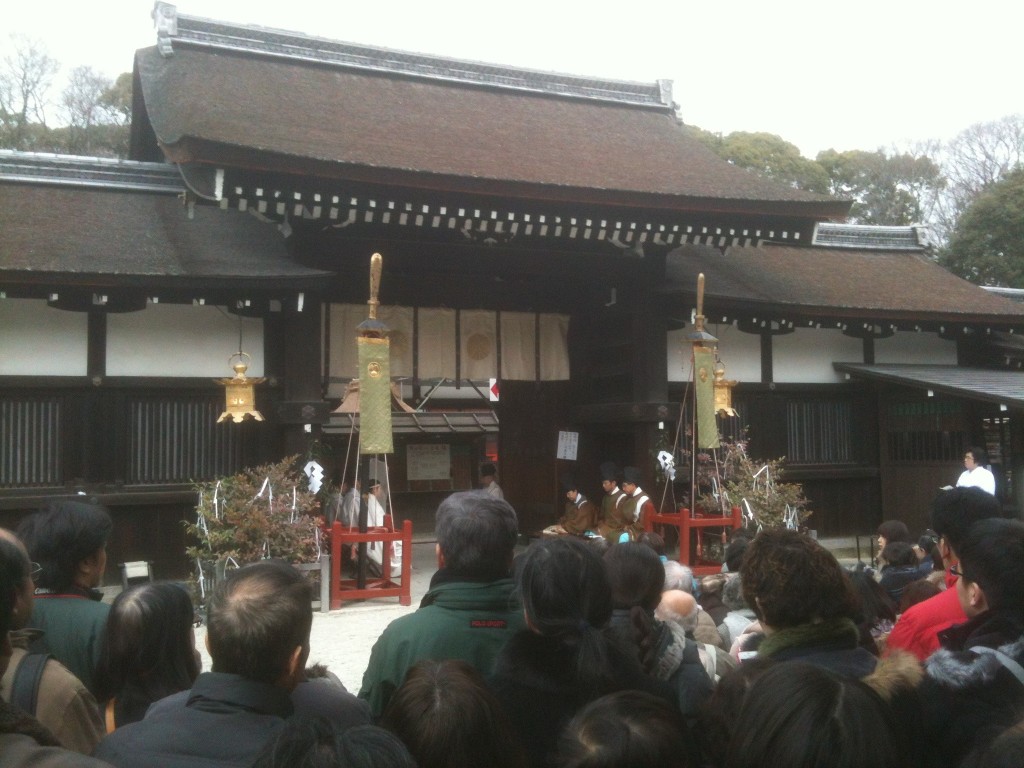
Gathered for the ritual at the entrance to the inner courtyard
My local shrine, Shimogamo, welcomes in the new year with a series of rites, one of which is kicking a football around (kemari) and another of which is kicking off worship at its zodiac shrines. The latter are unique as far as I know: at least I’ve never come across their like elsewhere.
Shimogamo’s main shrines are dedicated to clan founder, Kamo no Taketsunomi, and his daughter, Tamayorihime (see previous article). in the small courtyard in front of them stand much smaller shrines known as hokora, each of which is dedicated to one or two of the animals in the Chinese zodiac year.
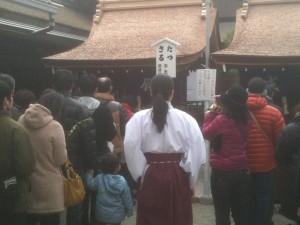
Two of the zodiac shrines, with miko (shrine maiden) in the foreground
There are seven shrines in all, five of which house pairs of animals. The dragon is paired with the monkey, the cow with the boar, the rabbit with the cock, the sea horse with the sheep, and the tiger with the dog. The horse and the rat get one each, making a grand total of twelve animals in all.
So why seven shrines is the obvious question? According to a shrine leaflet, they correspond to the seven manifestations of Okuninushi (Great Land Master), a kami associated with Izumo Shrine. Okuninushi, it turns out, has seven different names for the various guises in which he appears. All very interesting, but what’s Okuninushi got to do with the Chinese zodiac? Or indeed with Shimogamo? ‘The shrine is very old, there are many legends and stories which have been handed down since ancient times,’ a priest told me. ‘Actually we don’t know why.’
The ceremony took place at the entrance to the inner courtyard, and I guess there were about a thousand people in attendance. There was live gagaku music, and a priestess with a most unusual head dressing (rice twine tied round the head with a large bow at the back: see the photo).
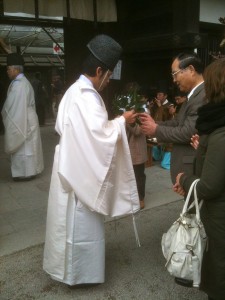
Receiving the tamagushi sprig
The short rites comprised offerings, purificatiion and norito prayer, before each of us were presented with a sprig of the sakaki tree (known as tamagushi) which we offered to our respective zodiac sign. Not surprisingly, the queue for the dragon was by far the longest, no doubt because people born in that year made a special point of attending.
Afterwards there was some delicious warm ginger-laced saké on sale and a chance to saunter around the Tadasu woods. There were a large number of saplings bearing labels, which I assumed to be identifications of the type of tree. However, they turned out to be the names of donors. At this rate every tree in the wood will pretty soon be identifiable by its donor – kind of strange for ancient woodland, I couldn’t help thinking, but managing woods in Japan is more costly and time-consuming than one might imagine.
This New Year ritual, like the others that precedes it, gives one a real sense of starting off something new. It’s that sense of renewal and revitalisation that Shinto is so good at cherishing. Let’s hope that launched in this way the year of the dragon proves to be reinvigorating for one and all!
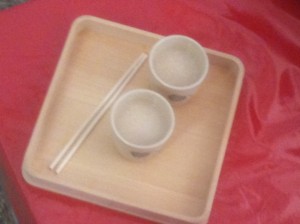
Some soul-warming sweet saké laced with ginger
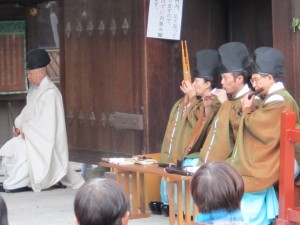
Gagaku musicians adding some mood music
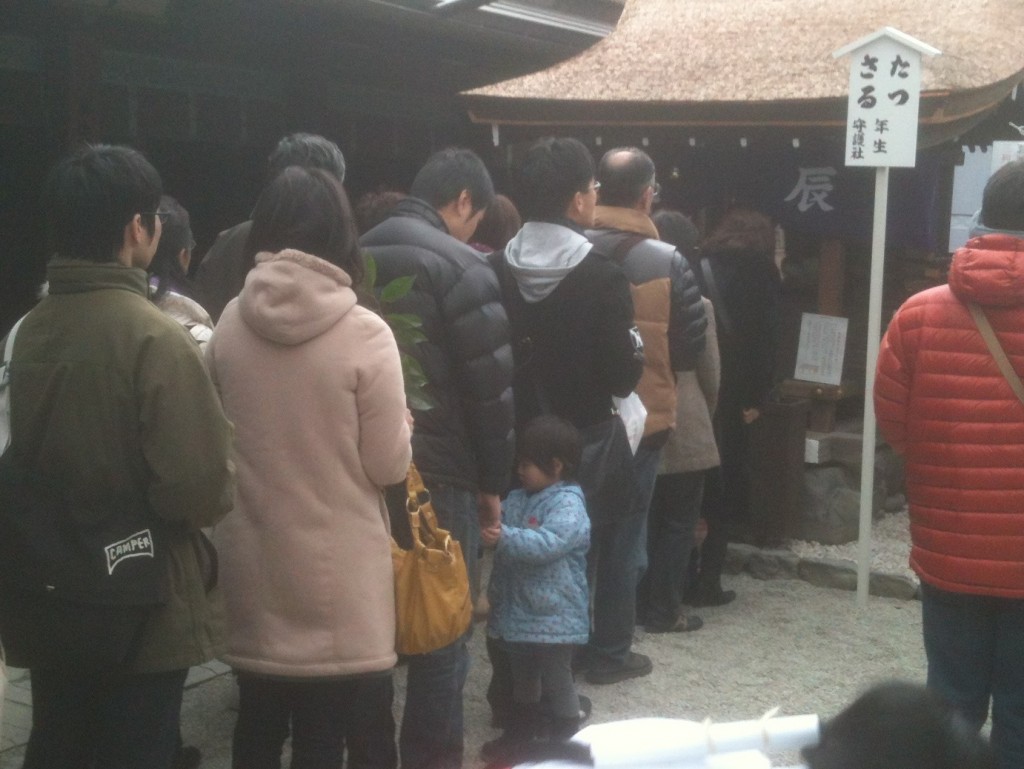
Queuing up at the dragon shrine, where as the sign indicates it peacefully coexists with the monkey

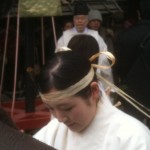
Shimogamo is one of my favourite shrines as well. I particularly like the small shrines for the different zodiac signs (a lovely example of the strong Chinese influences in Shinto). But there is one thing that surprises me in your story: you mention a seahorse! I know that the rabbit became a cat and the ox became a buffalo in Vietnam, and I know that the pig became a wild boar in Japan – but I have never heard of the snake becoming a seahorse… Interesting. Where did you get this information?
Good point, Aike!!
I thought it was a bit strange when I wrote it, so thanks for pointing it out… I was simply copying from the official Shimogamo website, which has an English language page… but as we all know, much gets lost in translation!!
For your information, here’s the relevant section from the website: the small zodiac shrines are collectively known as Koto Shrine, it seems:
(Quote follows from http://www.shimogamo-jinja.or.jp/pg217.html)
“The Koto shrine is actually a series of subshrines, each serving people of a particular Japanese zodiac sign. The Hitokoto east serves those born in the years of the Snake and the Sheep, while the Hitokoto west serves those born in the year of the Horse. The Futakoto north is for those born in the year of the Rat, while the south is for those born in the years of the Cow and Boar. The Mikoto north is for the Rabbit and the Cock, the south is for the Sea Horse and Monkey, and the middle is for the Tiger and the Dog. People come to the Koto shrine to pray for success in business and general prosperity.”